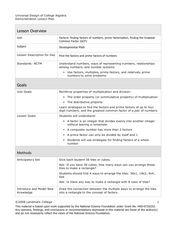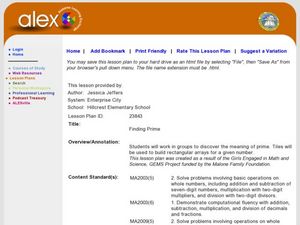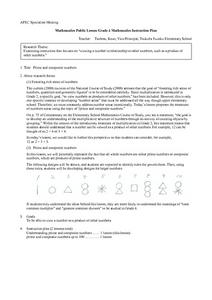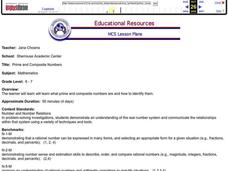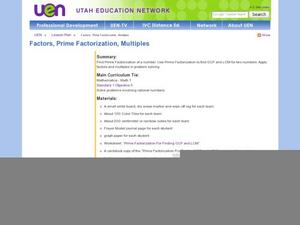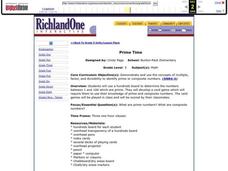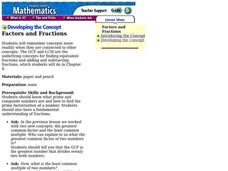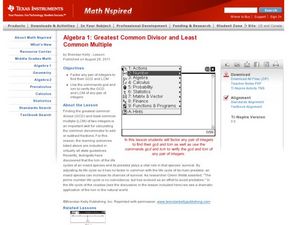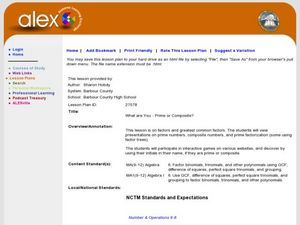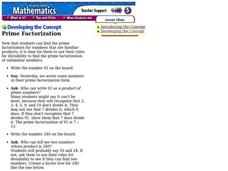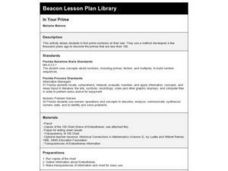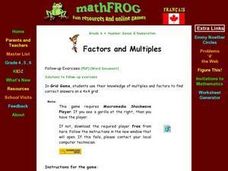Curated OER
Find the Factors and Prime Factors
Show the class how to find the factors of numbers. They use a variety of strategies, including unifix cubes, to find the factors of a whole number. This resource includes clear procedure to follow. Included are an anticipatory set,...
EngageNY
Least Common Multiple and Greatest Common Factor
Find the common denominator between prime factors, factor trees, and the distributive property. Scholars learn to find the least common multiple and greatest common factor of pairs of numbers. They rotate through stations to connect...
Math Solutions
Factor Game
Learning about factors and multiples is all fun and games with this simple math activity. The activity begins with the teacher and class playing the Factor Game together as students figure out the rules and uncover key...
Curated OER
Composite and Prime Numbers
Young math whizzes determine if a number is prime or composite. They use counters to participate in activities that show prime and composite numbers.
Alabama Learning Exchange
Finding Prime
Fifth and sixth graders explore prime numbers. They work with a partner to build rectangular arrays using twelve tiles. Factor pairs are noted and recorded on graph paper. Pupils construct rectangular arrays with a prime number and...
Curated OER
Prime and Composite Number Mini Lab
Elementary schoolers determine the attributes of prime and composite numbers. Pupils, working in pairs, participate in an activity in which they use manipulatives to show the rectangles that can be made from square tiles. They practice...
Curated OER
Time for Prime
Explore prime numbers. Learners use an interactive 100's chart to identify prime numbers, discuss a glossary of terms, use cards to list multiples of 2,3,4,5, and play a bingo game.
Curated OER
Prime Factorization: Finding Factors in the Fifth Grade
The lesson starts out with a brain drain, which is a great way to get students to activate prior knowledge and build lasting connections. They tell everything they know about prime factorization, use their knowledge to...
Curated OER
Prime And Composite Numbers - Fuzoku Elementary
Fourth graders investigate the concept of prime and composite numbers. Students study the visual representation for the numbers and use the pictures in order to develop designs for larger numbers. The goal of the lesson is for them to...
Curated OER
Prime and Composite Numbers
Prime and composite numbers are the focus of this mathematics instructional activity. In it, learners practice techniques for identifying these two types of numbers. They utilize the Inspiration program to complete a task that is clearly...
Curated OER
Factors, Prime Factorization, Multiples
Seventh graders examine Prime Factorizations, Multiples, and Factors. In this prime number, factorization, and multiples lesson, 7th graders identify greatest common factors and least common multiples. Students use problem solving skills...
Curated OER
Prime Time
Fifth graders complete activities related to prime and composite numbers. In this prime instructional activity, 5th graders make a hundreds chart with all the prime numbers. They create their own card game which deals with prime and...
Curated OER
Grade 5: Multiple Towers
Fifth graders use interlocking cubes to build towers to represent factors of numbers and place the towers in the appropriate places on a Tower chart in order to look for patterns. They work in partner groups, and finish by writing...
Curated OER
Factors and Fractions
Find the greatest common factor of numbers. Learners review prime and composite numbers and how to find the prime factorization of a number. They also review the greatest common factor, least common multiple, and learn new ways to find...
Texas Instruments
Greatest Common Divisor and Least Common Multiple
Students solve problems using the GCD and LCM. In this algebra lesson, students factor and simplify equations using the greatest common and least common factors and multiples. They factor integers in pairs.
Curated OER
Mission: Finding the LCM using Prime Factorization
In this prime factorization worksheet, students find the least common multiple of the given pair of numbers using factor trees. Students solve 10 problems.
Curated OER
Babylonian Mathematics I
Learners examine a Babylonian clay tablet and the mathematics found on it as a catalyst to investigate a variety of mathematical ideas. They work with prime numbers, classify numbers as whole, integer, rational, or irrational and use...
West Contra Costa Unified School District
Simplifying Radicals – Day 1
It doesn't get simpler than this. Scholars first learn to simplify radicals by determining the prime factors of the radicand. The lesson progresses to simplifying radicals involving algebraic expressions in the radicand.
Beacon Learning Center
Ten Pins
Multiplying with multiples of 10, 100, and 1,000 provides an opportunity to discuss patterns that arise with zeros. The class uses these patterns to solve problems. Then they rotate through three work stations, including a computer-based...
Curated OER
What Are You - Prime or Composite
Students explore the concept of prime factorization. In this prime factorization activity, students participate in an activity where they find the prime factorization and greatest common factor of a number derived from their name....
Curated OER
Prime Factorization
Students work with prime numbers. In this prime factorization lesson, students review writing numbers in their prime factorization form and solve multiple problems.
Curated OER
In Your Prime
Students study how to find prime numbers. They investigate the teachings of the mathematician Eratosthenes and apply his theory of prime numbers less than 100.
Curated OER
Factors and Multiples
Sixth graders need to see the relevance in the mathematics they learn. This lesson builds on the concepts of least common multiple and greatest common factor. The lesson presents real-world problem situations for students to solve.
Curated OER
Prime Real Estate
Students analyze and discuss prime numbers and the Sieve of Eratosthenes, a procedure to sort out prime numbers. They identify the prime numbers from 1-100 by eliminating all the multiples of the first four prime numbers, and circle what...
